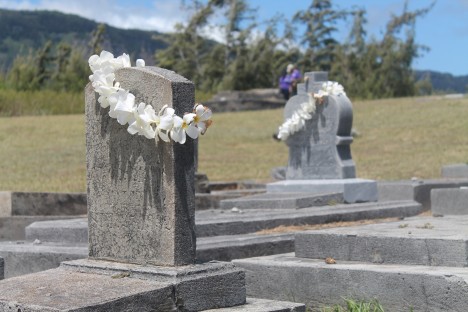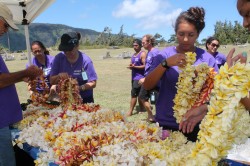Lei in Remembrance
With colorful lei draped carefully over each arm, volunteers set out across the gently sloping Papaloa cemetery in Kalaupapa last week with the goal of honoring and remembering each and every kupuna buried on the peninsula.
Pausing briefly at each marker to lay a hand or say a quiet prayer, the group quietly made their way through the acres of headstones, lovingly leaving a lei at each one.
The Makanalua peninsula, commonly known as Kalaupapa, serves as the final resting place for thousands of Hansen’s disease patients who were once banished there.
After more than a century of being exiled to the peninsula, patients were given the freedom to leave Kalaupapa on June 30, 1969, when Hawaii Revised Statute 326 lifted the ban on their isolation.
To celebrate the 45th anniversary of the lifting of this ban and honor all who lived and died there, 1400 lei were distributed to the four major cemeteries and every known burial site across the peninsula last Monday by a nonprofit organization called Hui Malama Makanalua.
“None of these kupuna will ever be forgotten,” said Kalaupapa National Park Service (KNPS) worker and cultural practitioner, Miki`ala Pescaia during the event’s opening ceremony. “We come to honor them. We come to recognize and show our appreciation for each and every one of them. “
Pescaia added that “we work today to forgive and work to restore all of the aloha back into these grounds that has been taken away.”
The project, called “Lei Hali`a O Kalaupapa” or “lei in remembrance of Kalaupapa” was created by Kerri Inglis, associate professor of history at the University of Hawaii, Hilo along with her current and past students, friends and family, many of whom have ancestral ties to the peninsula.
“The core group began with service trips we’ve been doing to Kalaupapa over the past seven or eight years,” said Inglis. “The last few years as part of the trip we take the time to make lei one evening and ask the students to choose some sites to place the lei.”
During one such trip, Inglis and her students saw KNPS workers placing flags on the graves of veterans. She said the visual of flags and lei commemorating all those buried there got them thinking.
“We started talking and thought wouldn’t it be good if we had enough lei for everyone. Everyone should have a lei and be remembered in that way,” she said.
Although only 1,200 of the graves are marked, Hui Malama Makanalua placed lei at known unmarked burial sites as well, in order to commemorate all 8,000 individuals who lived and died on the peninsula from 1866 to 1969.
Erika Stein Espaniola, superintendent of Kalaupapa National Historical Park, spoke with emotion during the morning’s ceremony as she shared her experiences of living in the community.
“It is important that we remember the stories and the experiences and what those experiences have taught us,” she said. “I know for myself, [the kupuna] have taught me about humility and humanity. Of love and devotion, of faith, of life and death.”
Boogie Kahilihiwa and Meli Watanuki represented fellow patient residents not in attendance and were asked to place the first lei of the day.

Photo by Laura Pilz.
“Who would believe that when we first came, things like this would happen,” Kahilihiwa said, referring to people willingly wanting to visit Kalaupapa. “Thank you so much for doing this, this sharing of aloha, but also of yourselves.”
Together they carefully selected lei from the billowing pile in front of them and set off into the cemetery.
The 1400 lei were created for the event, with many coming from other islands and as far away as California. According to Inglis, 80 lei came from California and over 400 lei came from topside Molokai.
“A couple weeks ago I wasn’t sure if we would have a couple hundred [lei],”confessed Inglis, who added that because of concerns over invasive species coming from other islands to Molokai, it was determined that it would be best if all the lei coming from the other islands be ti leaf lei.
“We are incredibly humbled and grateful for the support from so many people to make this happen,” Inglis said. “Every person that picked flowers or leaves for us, every person who helped make lei are here with us today. And the many kupuna from the couple hundred year history are here as well.”
Hui Malama Makanalua plans to make Lei Hali`a O Kalaupapa an annual event and is already planning next year’s ceremony. For more information or to receive updates on next year’s event please visit huimalamamakanalua.org.













Don't have a Molokai Dispatch ID?
Sign up is easy. Sign up now
You must login to post a comment.
Lost Password